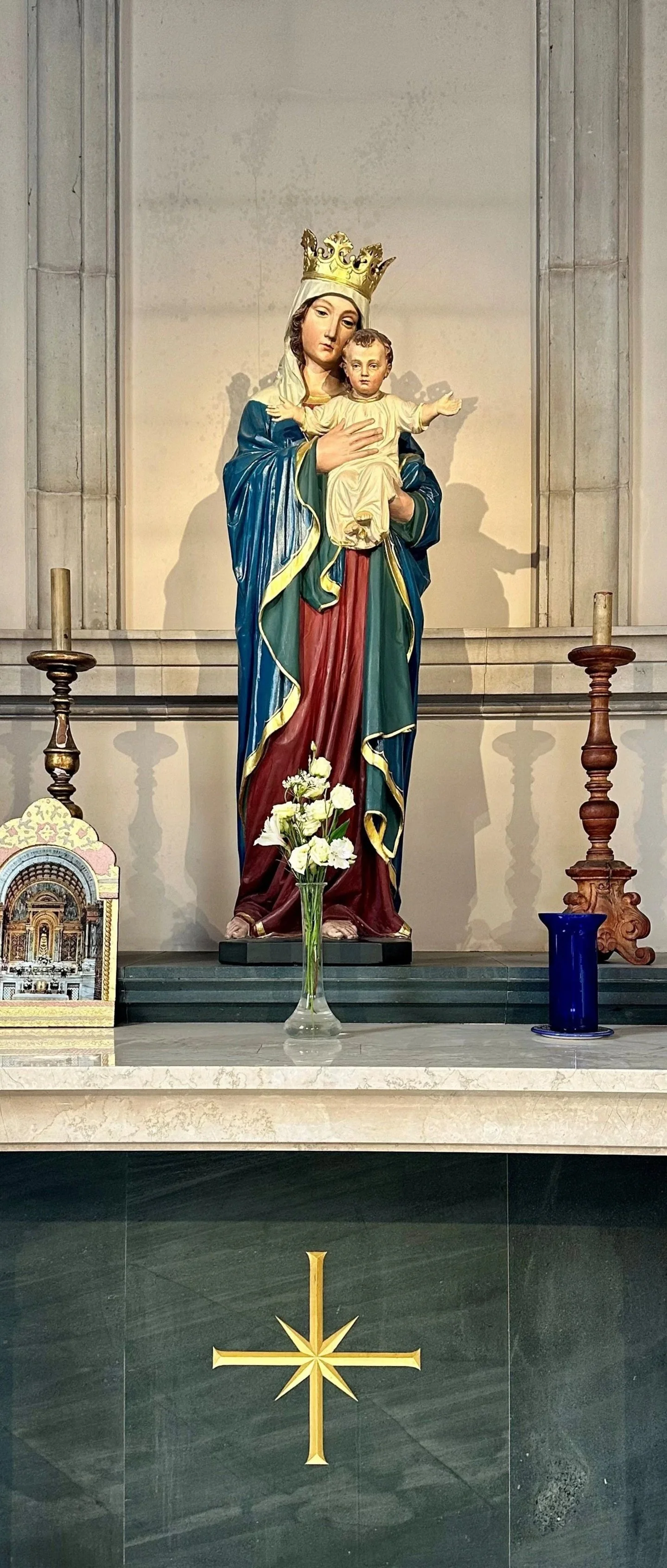Our Parish Church
The Parish of Our Lady of Loreto & St Winefride was founded in 1898 as a Mission Centre, when the Society of Mary (the Marists) were invited to establish a parish in Kew.
A house in Kew Gardens Road served as the Mission Chapel until a piece of waste ground nearby was secured as the site for a permanent church. The Church of Our Lady of Loreto & St Winefride was officially recognised by the Diocese of Southwark in 1905 and the building was completed and inaugurated in July 1906.
This church was substantially different from the one in which we worship today. Lack of funds prevented completion of the side aisles of the original design and the church therefore resembled a ‘T’ shape with the Sacred Heart and Lady chapels projecting out as wings. These side aisles were finally added in 1968, incorporating shrines, a new Baptistry and a Narthex. A large chapel, dedicated to St Peter Chanel, was located close to the Sacristy entrance.
The Sanctuary was remodelled in 1977, when the altar rails and the pulpit were removed, the large crucifix was moved to the back wall and the high altar was replaced with a simpler front-facing marble table.
Today we enter the church via the Narthex or vestibule, traditionally a gathering or meeting place where we can collect Mass and hymn books and where information is displayed.
The church is built in the Romanesque style as requested by our parish benefactor Miss Frances Ellis. Miss Ellis was a hugely generous supporter of the Catholic Church, financing some 46 churches including 20 in South London. In today’s money she donated £14 million towards new churches.
The apse at the eastern end of the church is typical of the Romanesque style. The modern altar table displays one of the porphyry marble panels from the original high altar; the table and columns supporting the tabernacle were repurposed from the old altar rails; and the tabernacle has been adapted from the 1906 sanctuary. The cross above the tabernacle was a gift from the Marists in 1977 and depicts the risen Christ in glory.
The large crucifix added to the sanctuary in 1910 now looks out across the church from beneath the organ loft. The Stations of the Cross are the oldest items in the church, being transferred from the Mission Chapel and re-sited first in 1910 and again in 1968.
The chapels either side of the Sanctuary no longer have their altars; the statues now stand on plinths on the wall. The Sacred Heart chapel remains in its original location and Our Lady’s chapel is now the one first dedicated to St Peter Chanel. St Winefride occupies the chapel to the right of the Sanctuary. The shrines reflect the Marist influence. Our Lady of Loreto was much loved by the Marist order and Miss Ellis wanted St Winefride in memory of her sister. St Peter Chanel was the first Marist martyr, a priest who worked and died in the Marist mission field of Oceania. The statue features the war club with which he was bludgeoned to death. St Therese of Lisieux is the patron saint of the missions and St Joseph is venerated as the guardian and protector of Our Lady and the child Jesus.
St Winefride’s chapel houses the parish First World War memorial. Records show that 7 young men died in action and 5 of these are marked RIP on the panel. Interestingly, the memorial was dedicated on 13th October 1918, almost a month before the end of the war, so we surmise that 2 more young men died before the Armistice. The memorial was a gift from Eugene and Ada Bisgood and is unusual in that it commemorates all those from the parish who served, not solely those who died.
The beautiful Annunciation window near the South Door was donated by the children of Eugene and Ada in memory of their parents. Above the images of Mary and Gabriel can be seen the miraculous transfer of the house of Nazareth by angels to Loreto. The small stained glass panel in the central window above the Sanctuary depicts the crucifixion and was installed post WWII, possibly to celebrate St Winefride’s Golden Jubilee.
The Baptistry is the circular chapel in the side aisle to the left of the entrance. The font was blessed in 1952, though we assume it was purchased much earlier. The original Baptistry is now the parish shop, situated at the far end of the Narthex.
The organ is considered one of the finest parish organs in South England and was installed in the early 1900s. To date, we have not been able to discover who built it.
If you would like a more detailed account of our church and its history, a book is available in the parish shop for £2.


